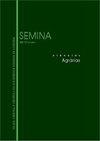In vitro control of phytopathogenic fungi and damping-off of tomato by Bacillus velezensis LABIM40 (CMRP 4489)
IF 0.5
4区 农林科学
Q4 AGRICULTURE, MULTIDISCIPLINARY
引用次数: 0
Abstract
The in vitro antagonistic activity of Bacillus velezensis LABIM40 (strain CMRP 4489) was assessed against Alternaria linariae, Botryotinia squamosa, Colletotrichum lindemuthianum, Gibberella zeae, and Rhizoctonia solani. An experiment was conducted using treated seeds under growth chamber conditions to determine the impact of various LABIM40 formulations on tomato seedling growth and the biocontrol of damping-off caused by R. solani. The treatments included the use of LABIM40 cell suspension, LABIM40 cell-free supernatant (CFS), 10 times concentrated CFS (10× CFS), commercial products based on Bacillus amyloliquefaciens (CP_1) and Bacillus subtilis (CP_2), and water. The effects of these products were assessed on tomato seedlings grown in sterile substrate or substrate inoculated with R. solani. In a dual culture test, B. velezensis LABIM40 inhibited the mycelial growth of the aforementioned fungal pathogens by 46.6%, 67.4%, 64.7%, 49.0%, and 54.4%, respectively. The minimum inhibitory concentration against each fungus was determined using varying concentrations of CFS in potato dextrose agar medium, followed by a regression analysis of mycelial growth inhibition. Except for A. linariae, the logarithmic model provided the best fit in all cases. Tomato seedlings from seeds treated with 10× CFS in inoculated substrate exhibited a survival rate 57% higher than that exhibited by the control treatment. However, no growth promotion was observed in tomato plants from seeds treated with LABIM40 cells or its CFS metabolites. In summary, these findings highlight the antagonistic activity of B. velezensis LABIM40 against A. linariae, B. squamosa, C. lindemuthianum, G. zeae, and R. solani, as demonstrated by dual culture and CFS diffusion tests. This suggests its potential as a biocontrol agent for damping-off in tomatoes.velezensis LABIM40 (cmrp4489)对番茄植物病原真菌的体外控制及抑菌作用
研究了velezensis LABIM40菌株(cmrp4489)对玉米赤霉、鳞状芽孢杆菌、林氏炭疽杆菌、玉米赤霉素和solani根丝核菌的体外拮抗活性。以处理过的番茄种子为试验材料,在生长室条件下,研究了不同配方LABIM40对番茄幼苗生长的影响及对番茄枯萎病的生物防治效果。处理包括LABIM40细胞悬浮液、LABIM40无细胞上清液(CFS)、10倍浓缩CFS (10× CFS)、解淀粉芽孢杆菌(CP_1)和枯草芽孢杆菌(CP_2)的市售产品和水。分别在无菌基质和接种番茄枯萎菌基质上对番茄幼苗进行了效果评价。在双培养试验中,B. velezensis LABIM40对上述真菌病原菌菌丝生长的抑制作用分别为46.6%、67.4%、64.7%、49.0%和54.4%。在马铃薯葡萄糖琼脂培养基中使用不同浓度的CFS确定对每种真菌的最低抑制浓度,然后对菌丝生长抑制进行回归分析。对对数模型的拟合效果最好,除线麻外。接种10倍CFS处理的番茄幼苗存活率比对照高57%。然而,LABIM40细胞或其CFS代谢物处理的种子对番茄植株的生长没有促进作用。综上所述,通过双重培养和CFS扩散试验,这些发现突出了B. velezensis LABIM40对linariae、B. squamosa、C. lindemuthianum、G. zeae和R. solani的拮抗活性。这表明它有潜力作为一种生物防治剂来防治番茄的湿化。
本文章由计算机程序翻译,如有差异,请以英文原文为准。
求助全文
约1分钟内获得全文
求助全文
来源期刊

Semina-ciencias Agrarias
农林科学-农业综合
CiteScore
1.10
自引率
0.00%
发文量
148
审稿时长
3-6 weeks
期刊介绍:
The Journal Semina Ciencias Agrarias (Semina: Cien. Agrar.) is a quarterly publication promoting Science and Technology and is associated with the State University of Londrina. It publishes original and review articles, as well as case reports and communications in the field of Agricultural Sciences, Animal Sciences, Food Sciences and Veterinary Medicine.
 求助内容:
求助内容: 应助结果提醒方式:
应助结果提醒方式:


